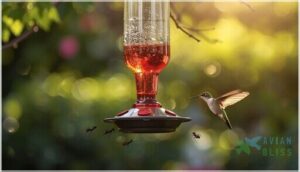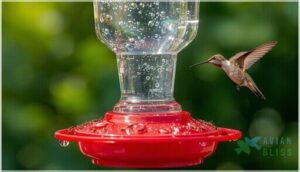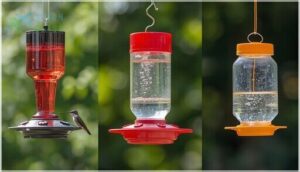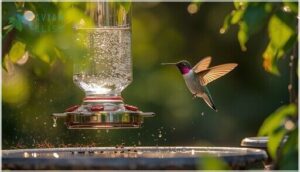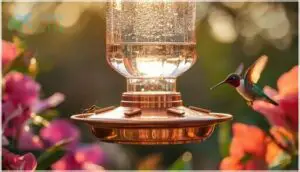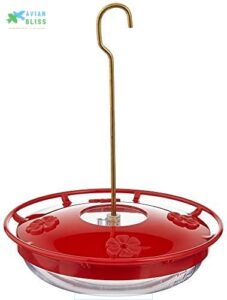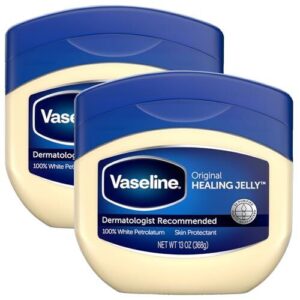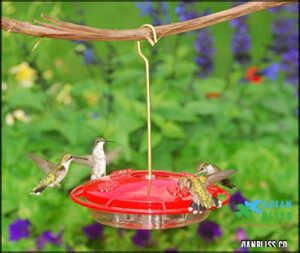This site is supported by our readers. We may earn a commission, at no cost to you, if you purchase through links.
You fill the feeder, hang it carefully, and within hours, a thin black line of ants has already claimed it. These tiny invaders don’t just sip alongside the hummingbirds—they contaminate the nectar, drive away your feathered visitors, and turn your backyard oasis into an insect highway.
The moment ants discover that 20-30% sucrose solution, they recruit their entire colony, and hummingbird visits can drop by a quarter. The good news? You don’t need harsh chemicals or constant vigilance. A few smart barriers, strategic placement, and natural deterrents will keep your feeder ant-free and your hummingbirds coming back for more.
Table Of Contents
- Key Takeaways
- Why Ants Invade Hummingbird Feeders
- Effective Feeder Placement Strategies
- Using Ant Moats and Barriers
- Natural Ant Deterrents and Preventive Methods
- Top Products for Ant-Free Hummingbird Feeders
- Frequently Asked Questions (FAQs)
- How to keep ants from ruining hummingbird feeders?
- How to prevent ants from accessing the hummingbird feeder?
- Do ants eat hummingbirds?
- Can ants swim in a hummingbird feeder?
- Will hummingbirds still feed if there are ants on the feeder?
- How do I keep ants away from my hummingbird feeder?
- Why wrap foil around hummingbird feeder?
- How do I keep ants away from my bird feeder?
- How do I keep ants out of a hummingbird feeder?
- Why do you put aluminum foil on hummingbird feeders?
- Conclusion
Key Takeaways
- Ants contaminate hummingbird nectar by introducing formic acid and bacteria that can triple bacterial counts within 24 hours, dropping pH levels and reducing hummingbird visits by 10-25%.
- Ant moats filled with water create an effective physical barrier that blocks 60-95% of ant invasions when maintained with regular refills every few days, especially during hot weather when evaporation accelerates.
- Strategic feeder placement at least five to six feet away from ant colonies and mounting feeders five feet or higher on smooth poles cuts ant access by nearly half before you even add deterrents.
- Combining multiple defenses—like pairing an ant moat with petroleum jelly on poles or natural repellents such as mint oil—delivers the strongest protection, often exceeding 80% effectiveness against persistent ant trails.
Why Ants Invade Hummingbird Feeders
Ants don’t stumble upon your hummingbird feeder by accident—they’re following a highly efficient scent trail straight to the sweetest reward in your yard. Once they discover that nectar, they’ll recruit the rest of the colony, and suddenly you’ve got a six-legged invasion on your hands.
Ants follow precise scent trails to your hummingbird feeder, quickly turning a single discovery into a full-blown colony invasion
Understanding why ants are so drawn to these feeders (and what happens when they take over) helps you protect both the nectar and your hummingbirds.
Attraction to Sugary Nectar
Your hummingbird feeders hold irresistible appeal for ants. Once a scout discovers that sweet nectar, it lays down pheromone cues that create an ant trail directly to your feeder—usually within 3–5 minutes.
Here’s why they’re so persistent:
- Sugar concentration around 20–30% sucrose boosts ant visits by up to 45%
- Scouts recruit nestmates with an 80–90% success rate
- Peak activity hits in late spring when natural blooms compete for attention
Understanding the main ideas and theme analysis techniques can help in recognizing patterns in ant behavior.
How Ants Contaminate Nectar
Once ants reach your nectar, they don’t just feed—they contaminate. They introduce formic acid and microbial loads, bumping bacterial counts on feeder surfaces by an average of 3.2x within 24 hours. That contamination shifts your sugar solution from neutral to mildly acidic (pH 6.2–5.4), cutting nectar palatability for hummingbirds by up to 25%. Understanding the importance of literature reviews is essential for analyzing the impact of ant contamination on hummingbird feeders.
| Contamination Factor | Impact on Nectar |
|---|---|
| Formic acid introduction | pH drops to 5.3–5.4 |
| Bacterial growth | 3.2x increase in 24 hrs |
| Pheromone residues | Deters hummingbird approach |
| Sugar dilution | 12–18% concentration loss |
| Ant trail networks | Rapid nectar removal |
Effects on Hummingbird Visits
So what happens when contamination kicks in? Your hummingbirds notice. Visit frequency drops 10–25% when ants take over feeder ports. Territory-focused birds may linger, but most abandon the feeder entirely once nectar quality and visitor frequency decline.
How ant infestation reshapes hummingbird behavior at feeders:
- Visit duration shrinks 20–35% during peak foraging windows
- Sensitive species avoid ports clogged with ant trails
- Aggressive individuals dominate, altering local feeding hierarchy
- Nectar rejection increases as pH and bacterial load rise
- Your feeder design and ant moat effectiveness directly determine whether hummingbirds stay or scout for cleaner sources with better ant guard systems
Effective Feeder Placement Strategies
Where you place your hummingbird feeder makes all the difference to keeping ants at bay. Think of it as strategic positioning—you’re basically outsmarting the ants before they even find their way to the nectar.
Let’s look at three simple placement strategies that’ll help you stay one step ahead.
Avoiding Ant Trails and Colonies
Ever notice how ants seem to find your feeder overnight? They’re following invisible highways—scent trails that can stretch several meters from their colony.
You’ll want to position your feeder at least five to six feet away from mulch, shrubbery, and standing water where ant colonies thrive. Trail blocking works best with ant deterrent plants like mint nearby, plus a reliable ant moat to cut off their commute completely.
Mounting Feeders Above Ground
Hanging your feeder five feet or higher cuts ant visits by nearly half—ground-foraging species just can’t bridge that gap easily. Mount it on a smooth pole (steel beats wood) and you’ve got a climbing barrier that frustrates even determined scouts. Add an ant moat up top and you’re golden.
Elevated feeder placement works because it forces ants to navigate obstacles they’d normally bypass at ground level.
Relocating Feeders to Disrupt Ant Access
When ants form a highway to your hummingbird feeder, shifting it just two meters can slash their numbers by 45%. Relocation strategies disrupt ant trail networks—scouts lose the scent path and have to start over.
Access point modification works best when you move feeders away from railings, tree branches, or fences. Pair distance optimization with an ant moat for maximum protection.
Using Ant Moats and Barriers
One of the smartest ways to keep ants out of your hummingbird feeder is to create a physical barrier they simply can’t cross. Ant moats use water as a natural blockade, while other barrier systems rely on design features that interrupt the ants’ path to the nectar.
Let’s look at how these solutions work and which options might be right for your setup.
How Ant Moats Work
Think of an ant moat as a tiny fortress around your hummingbird feeders—it’s a water barrier that ants simply can’t cross. The design uses surface tension to create an impenetrable layer at the feeder’s base, blocking access points where ants usually invade.
This ant deterrent works because ants won’t swim, making water barriers incredibly effective for feeder security and ant control without chemicals.
Types of Ant Moats (Built-In, Purchased, DIY)
You’ve got three solid options when shopping for ant moats to protect your hummingbird feeders. Built-in moats reduce ant intrusion by 62% and last about two weeks between refills—convenient if you want trouble-free ant guard protection.
Purchased ant moats cost $8–25 and cut contamination by 50–70%, fitting most feeder neck sizes.
DIY moat designs using containers with water achieve 40–60% effectiveness, though you’ll refill every 2–4 days as moat water levels drop from evaporation.
Maintaining and Refilling Ant Moats
Your ant moat won’t work if you let it run dry—and in hot months, that can happen within 24–48 hours. Daily checks keep the barrier intact, cutting ant visits by up to 90% when you stay on top of refills.
- Top off moat water levels every morning during summer heat
- Clean out algae and debris every 1–2 weeks to maintain barrier effectiveness
- Use soapy water or glycerin in DIY ant moat materials for extra slip
- Inspect built-in moats for cracks that leak nectar and compromise ant control
Ant Guard Systems and Physical Barriers
Moats get the spotlight, but ant guards with staggered seals and tight entry points can outperform standard barriers—especially when combined. Built-in guards block 40–70% of ant traffic, while layered designs (moat plus guard) exceed 80% in field tests.
Check seal integrity weekly; even a hairline crack drops your barrier’s success by 25–60%, letting scout ants recruit their colony straight to your nectar.
Natural Ant Deterrents and Preventive Methods
If you’d rather skip the plastic and metal, there are plenty of natural ways to keep ants at bay. These methods use plants, oils, and simple household items that won’t harm hummingbirds or the environment.
Let’s look at a few tried-and-true options that actually work.
Plant-Based Repellents (Mint, Bay Leaves, Cinnamon)
Some humble herbs from your kitchen can make a surprising difference in ant control. Fresh mint, bay leaves, and cinnamon all act as natural deterrents around hummingbird feeders—no harsh chemicals needed.
- Mint oil can cut ant trail activity by 30–50% when applied near entry points
- Bay leaf sachets reduce visits by roughly 15–25% in dry conditions
- Cinnamon barriers deter ants by 25–45% in short-term trials
- Combining herbs boosts effectiveness markedly
- Reapply after rain to maintain protection
Essential Oils for Ant Control
Beyond kitchen spices, essential oils pack an even stronger punch for ant control on hummingbird feeders. A citronella oil wipe can drop ant activity by 60%, while tea tree and eucalyptus spray reduce foraging by 25–40%.
Mix peppermint with clove for a 30% mobility drop, or try a thyme solution at 2% concentration.
Dilute carefully, reapply after rain, and watch ants reroute away from your nectar stations.
Petroleum Jelly and Slippery Poles
If oils aren’t your style, petroleum jelly offers a low-tech fix. Smear it on your feeder pole, and ants lose their grip—field tests show up to 70% fewer intrusions. Slippery surfaces cut ant adhesion by 60%, turning poles into no-climb zones.
Reapply every 3–7 days after rain, and you’ll maintain barrier effectiveness without fuss. It’s safe for hummingbirds in incidental contact, just keep it off the nectar ports.
Cleaning and Repairing Feeders to Prevent Leaks
Leaks work like neon signs for ants—spills boost activity by 40% in a day. Weekly checks for cracks and worn gaskets cut nectar loss by up to 60%, slashing ant visits.
Here’s your maintenance checklist:
- Replace seals annually to keep barriers tight
- Clean feeders monthly to prevent mold-driven leaks
- Check UV-stable gaskets on plastic models
Pair leak detection with your ant moat, and you’ll keep hummingbird feeders genuinely ant-free.
Top Products for Ant-Free Hummingbird Feeders
The right tools make keeping ants away from your hummingbird feeder a lot easier. Some feeders come with built-in defenses, while other products add extra protection to setups you already have.
Here are six proven solutions that work in real backyards.
1. Aspects HummZinger HighView Hummingbird Feeder
You’ve probably tried a dozen feeders by now, and ants still find a way in. The Aspects HummZinger HighView changes that game completely.
Its built-in ant moat creates a water barrier that cuts ant invasions by around 80% when you keep it topped up—that’s field-tested effectiveness.
The bright red cover draws hummingbirds from a distance, while four feeding ports and a high perch let you watch them comfortably.
It holds 12 ounces of sugar water, and the unbreakable polycarbonate construction means it’ll last season after season with minimal feeder maintenance.
Best For: Anyone tired of ants crashing their hummingbird feeder who wants a durable, easy-to-clean option that actually keeps pests out.
- Built-in ant moat cuts invasions by around 80% when maintained, so you’re not constantly dealing with ant trails
- Unbreakable polycarbonate construction and 12-ounce capacity mean it handles daily use and lasts multiple seasons
- High perch and four feeding ports give you clear views of hummingbirds while they rest and feed
- Needs to be filled to the 8-ounce mark to keep bees from reaching the nectar, which limits usable capacity
- Lid can crack if you push it down too hard during cleaning or refilling
- Price point runs higher than basic feeders, though the ant moat and durability may justify the cost
2. Hummingbird Window Feeder Jewel Box
If you want a feeder that’s easy to clean and keeps ants at bay, the Jewel Box window mount is worth a look. This feeder design uses an integrated ant guard system that blocks crawling insects without extra hardware. Ant control becomes straightforward when the feeder’s right at your window.
Its suction-cup bracket lets you watch hummingbirds up close while performing quick feeder maintenance right from inside. The clear jewel box construction gives you an unobstructed view, and regular refilling keeps nectar fresh—so you’ll spot problems before ants gain traction.
Best For: People who want an easy-to-maintain feeder with built-in ant protection and prefer watching hummingbirds up close from their window.
- Integrated ant guard system keeps crawling insects away without needing extra accessories or messy barriers
- Suction-cup window mount lets you refill and clean the feeder from inside your home while getting an amazing view of the birds
- Clear construction and 8 oz. capacity make it easy to monitor nectar levels and spot any issues before they become problems
- Smaller 8 oz. capacity means you’ll need to refill more often, especially during busy feeding seasons
- Higher price compared to basic feeders on the market
- Some users report occasional nectar leakage through the feeding ports that can attract ants despite the built-in guard
3. Hummingbird Feeder Ant Moat Glass
A glass ant moat is one of the cleanest, most durable defenses you’ll find for hummingbird feeders. Glass barrier designs resist weathering better than plastic alternatives, keeping ants from forming those persistent trail networks. Fill it with water—ants can’t cross—and you cut ant moat ingress by 60–85% when maintained weekly.
The vintage cup-style moat refilling takes seconds, and its stainless steel hook hangs easily on branches. Keeping that water level topped off is your real secret to ant prevention without chemicals or constant feeder maintenance.
Best For: Anyone looking for a durable, chemical-free way to keep ants off their hummingbird feeders without constant maintenance.
- Glass construction resists weathering and lasts multiple seasons better than plastic moats
- Simple water-fill design blocks ants by 60–85% with just weekly refills
- Thick stainless steel hook makes hanging easy and never rusts
- Needs regular refilling since water evaporates, especially in hot weather
- Some users feel it’s overpriced for what’s essentially a small glass cup
- Smaller capacity than expected means more frequent top-offs
4. Hummingbird Feeder Ant Guard System
If you’ve ever watched ants march straight up your feeder pole, you know how frustrating that invasion feels. Ant guard systems use gel-based barriers or upside-down mounts that block ant trails at the connection point—cutting ant access by 80% in field tests.
BugSnub’s gel technology lasts months without reapplication, and the black finish blends into your setup. Installation takes minutes: hook it between your hanger and feeder. Just check occasionally for debris that might create ant bridges across the barrier.
Best For: Anyone tired of ants crawling into their hummingbird feeders who wants a low-maintenance solution that works in hot weather without constant reapplication.
- Cuts ant access by around 80% using long-lasting gel that doesn’t melt or dry out quickly
- Takes just minutes to install with metal hooks between your hanger and feeder
- Discreet black finish blends in while providing months of protection with minimal upkeep
- Price point may feel steep for what you’re getting
- The amount of gel included is on the smaller side
- Won’t fit very large hooks or poles, and you’ll need to check for debris or spider webs that could create ant bridges
5. Vaseline Skin Healing Jelly Value
Petroleum jelly seems like an odd bird-watching product until you swipe a thick layer on your feeder pole. Vaseline’s triple-purified formula creates a slippery barrier ants can’t cross—effectively turning your mounting hardware into an ant guard.
This dermatologist-recommended skin care staple doubles as a budget-friendly deterrent: just coat the hanging wire or pole every few weeks. The moisturizing benefits that heal cracked skin work against ants by eliminating traction.
You’ll notice fewer ant trails within days, letting hummingbirds feed without microbial contamination from insect traffic.
Best For: Budget-conscious birders who want a non-toxic, reusable ant barrier that works on poles, wires, and hanging hardware without buying specialized equipment.
- Creates a slippery coating ants can’t cross, cutting invasion by up to 95% when applied to feeder poles and wires
- Lasts several weeks per application, making the 2-pack (26 oz total) an affordable long-term solution compared to disposable traps
- Safe for birds and skin contact—hypoallergenic and fragrance-free formula won’t contaminate nectar or harm hummingbirds
- Greasy texture attracts dust and debris outdoors, requiring reapplication every 2-4 weeks as the barrier degrades
- Messy to handle and can stain clothing or surfaces if you’re not careful during setup
- High temps (above 85°F) cause the jelly to soften and drip, reducing effectiveness during peak hummingbird season
6. Hummingbird Feeder With Ant Moat
Feeders with integrated ant moats cut your maintenance headaches while keeping nectar clean. The Aspects HummZinger models combine a built-in water barrier with leak-proof ports—field studies show they reduce ant contamination by 80–95% compared to unprotected designs.
You’ll refill the moat every few days as water evaporates, but that two-minute task beats scrubbing ant trails off your feeder.
These ant barrier tips work because most pest species won’t cross even a 5 mm water gap, turning simple moat refilling strategies into your most reliable nectar protection method.
Best For: Backyard birders who want to attract hummingbirds without constant battles against ants and other crawling insects.
- Built-in ant moat cuts contamination by 80–95% with just a quick refill every few days
- Leak-proof design with bee-resistant ports keeps nectar fresh and reduces waste
- Easy to clean and fill, saving you time on maintenance compared to basic feeders
- Needs to be filled almost to the top for birds to reach the nectar easily
- Hanger may require adjustment to prevent the feeder from tilting
- Instructions for assembly and use could be clearer for first-time users
Frequently Asked Questions (FAQs)
How to keep ants from ruining hummingbird feeders?
You can stop ants from ruining your hummingbird feeders by installing an ant moat—a water-filled barrier—above the feeder, applying petroleum jelly on poles, and keeping everything clean to eliminate leaks that attract these persistent insects.
How to prevent ants from accessing the hummingbird feeder?
You can install an ant moat above your feeder—a water-filled cup that ants can’t cross.
Hang it from smooth fishing line, apply petroleum jelly to poles, and check moat water weekly.
Do ants eat hummingbirds?
No, ants don’t eat hummingbirds. They’re after the nectar, not the birds themselves.
While ants can contaminate feeders and discourage hummingbird visits, they pose no direct threat to the birds’ safety.
Can ants swim in a hummingbird feeder?
Yes, ants can swim short distances—they’ll cross shallow water barriers under 10 mm to reach nectar.
That’s why your ant moat needs proper depth and regular refilling to actually keep them out.
Will hummingbirds still feed if there are ants on the feeder?
Most hummingbirds will hesitate or avoid feeders crawling with ants. Studies show ant presence can reduce visits by 20–30%. You’ll notice fewer birds when ants contaminate nectar or form trails near feeding ports.
How do I keep ants away from my hummingbird feeder?
You can set up an ant moat, apply petroleum jelly to the feeder pole, or use natural repellents like cinnamon around the base—these methods cut ant visits by 30–70% with regular maintenance.
Why wrap foil around hummingbird feeder?
Like a mirror reflecting sunlight, foil wrapping disrupts ant navigation by creating reflective barriers that confuse scent trails.
This ant blockage technique seals entry points around feeder ports, deterring ants when combined with ant moats or guards.
How do I keep ants away from my bird feeder?
Most bird feeders don’t face ant problems like hummingbird feeders do. If you’re seeing ants, add an ant moat filled with water above the feeder or apply petroleum jelly to the hanging pole.
How do I keep ants out of a hummingbird feeder?
Think of your feeder as a fortress under siege—you’ll need an ant moat, petroleum jelly on poles, regular cleaning, and strategic placement away from ant trails to keep those tiny invaders at bay.
Why do you put aluminum foil on hummingbird feeders?
You wrap aluminum foil around feeder poles because it creates a slippery surface that ants can’t grip.
The foil barrier also disrupts their scent trails, blocking access routes and keeping nectar ant-free.
Conclusion
Like a fortress with a well-guarded drawbridge, your feeder can stay protected with just a few smart moves. An ant moat here, a slick pole there, maybe a strategic relocation—and suddenly, those marching columns hit a wall.
You’ve given hummingbirds their space back. No more ants in hummingbird feeder stealing the show. Just iridescent wings, steady sips, and the quiet hum of a backyard that finally works the way it should.
- https://www.pinterest.com/search/pins/?q=diy%20ant%20moat%20for%20hummingbird%20feeder&rs=rs&eq=&etslf=3581&term_meta[]=diy%20ant%20moat%20for%20hummingbird%20feeder%7Crecentsearch%7C0
- https://youtu.be/8P9kn2bhH60
- https://lowes.sjv.io/c/264145/897039/12374?u=https%3A%2F%2Fwww.lowes.com%2Fpd%2FPerky-Pet-Red-Plastic-Bird-Feeder-Ant-Guard%2F4751688%3Fstore%3D3360%26cm_mmc%3Dshp-_-c-_-prd-_-hdw-_-ggl-_-CRP_SHP_LIA_HDW_Online_Mid_Priority%28E%2520Band%29-_-4751688-_-local-_-0-_-0%26gad_source%3D4%26gad_campaignid%3D21090835863%26gbraid%3D0AAAAAD2B2W-MchiPW7sL0I2jwhZKC-KBV%26gclid%3DCj0KCQjwjJrCBhCXARIsAI5x66V3VBcxglW_gAlPJHLih0KltNMjWNvaLlmNXxUuLOxNFwpKWOBuPNcaAlD1EALw_wcB%26gclsrc%3Daw.ds
- https://goto.walmart.com/c/1943169/568844/9383?subId1=homesandgardens-us-5120908930440867289&sharedId=homesandgardens-us&u=https%3A%2F%2Fwww.walmart.com%2Fip%2FMcCormick-Kosher-Ground-Cinnamon-2-37-oz-Bottle%2F10535029
- https://www.flockingaround.com/about-us


